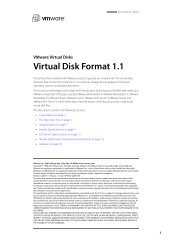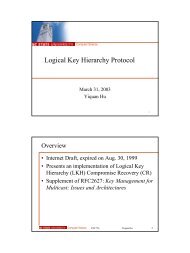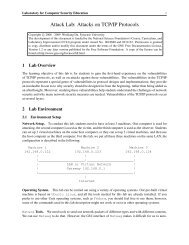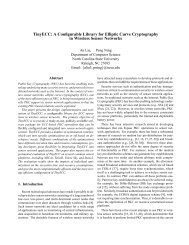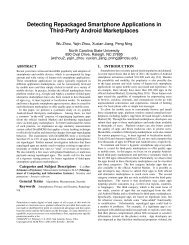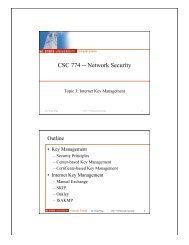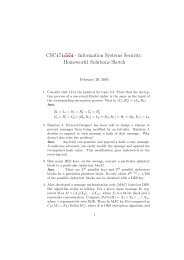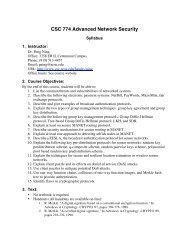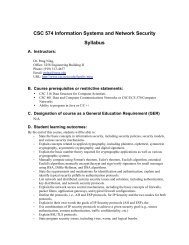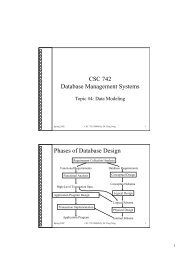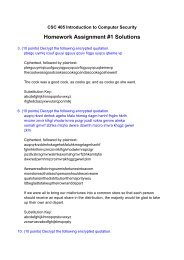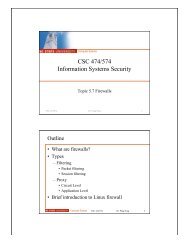Tracing Traffic through Intermediate Hosts that Repacketize Flows
Tracing Traffic through Intermediate Hosts that Repacketize Flows
Tracing Traffic through Intermediate Hosts that Repacketize Flows
You also want an ePaper? Increase the reach of your titles
YUMPU automatically turns print PDFs into web optimized ePapers that Google loves.
<strong>Tracing</strong> <strong>Traffic</strong> <strong>through</strong> <strong>Intermediate</strong> <strong>Hosts</strong><br />
<strong>that</strong> <strong>Repacketize</strong> <strong>Flows</strong><br />
Young June Pyun ∗ , Young Hee Park ∗ , Xinyuan Wang † , Douglas S. Reeves ∗ and Peng Ning ∗<br />
∗ Department of Computer Science<br />
North Carolina State University, Raleigh, NC 27695, USA<br />
Emails: {yjpyun,ypark3,reeves,pning}@ncsu.edu<br />
† Department of Information and Software Engineering<br />
George Mason University, Fairfax, VA 22030, USA<br />
Email: xwangc@gmu.edu<br />
Abstract—<strong>Tracing</strong> interactive traffic <strong>that</strong> traverses stepping<br />
stones (i.e., intermediate hosts) is challenging, as the packet<br />
headers, lengths, and contents can all be changed by the stepping<br />
stones. The traffic timing has therefore been studied as a means<br />
of tracing traffic. One such technique uses traffic timing as a<br />
side channel into which a watermark, or identifying tag, can<br />
be embedded to aid with tracing. The effectiveness of such<br />
techniques is greatly reduced when repacketization of the traffic<br />
occurs at the stepping stones. Repacketization is a natural effect<br />
of many applications, including SSH, and therefore poses a<br />
serious challenge for traffic tracing.<br />
This paper presents a new method of embedding a watermark<br />
in traffic timing, for purposes of tracing the traffic in the presence<br />
of repacketization. This method uses an invariant characteristic<br />
of two traffic flows which are part of the same stepping stone<br />
chain, namely, elapsed time of the flows. The duration of each<br />
flow is sliced into short fixed-length intervals. Packet timing is<br />
adjusted to manipulate the packet count in specific intervals,<br />
for purposes of embedding the watermark. A statistical analysis<br />
of the method, with no assumptions or limitations concerning<br />
the distribution of packet times, proves the effectiveness of the<br />
method given a sufficient number of packets, despite natural<br />
and/or deliberate repacketization and perturbation of the traffic<br />
timing by an adversary. The method has been implemented<br />
and tested on a large number of synthetically-generated SSH<br />
traffic flows. The results demonstrate <strong>that</strong> 100% detection rates<br />
and less than 1% false positive rates are achievable under<br />
conditions of 2 seconds of maximum timing perturbation and<br />
12% repacketization rate, using fewer than 1000 packets.<br />
I. INTRODUCTION<br />
Network-based attacks are a serious threat to the Internet<br />
community. Despite the development of sophisticated defense<br />
mechanisms, attacks continue to increase. Unfortunately, identifying<br />
the source of an attack is a challenging task due<br />
to the anonymous nature of the Internet [1] and evasion<br />
techniques [2]–[5] available to the attackers. In the case of an<br />
interactive attack, where an attacker interacts with a remote<br />
victim host using applications such as telnet/ssh, one of the<br />
simplest ways to hide the source of an attack is staging the<br />
attack <strong>through</strong> a series of intermediate hosts, called stepping<br />
stones. <strong>Tracing</strong> such an attack back to the origin is difficult<br />
This work was supported by DTO under contract NBCHC030142. The<br />
contents of this paper do not necessarily reflect the position or the policies of<br />
the U.S. Government.<br />
since the attack is staged <strong>through</strong> several TCP connections, and<br />
the packet headers, lengths, and contents can all be changed by<br />
the stepping stones. Existing IP traceback techniques [6], [7]<br />
will only trace packets back to the last stepping stone in the<br />
sequence. Note <strong>that</strong> although this paper discusses tracing an<br />
attack, it is not confined to such traffic and can be generalized<br />
to tracing any traffic generated by interactive communication<br />
protocols (ssh/telnet). We limit our scope to interactive traffic<br />
due to its timing constraints; the amount of delays (or noise)<br />
<strong>that</strong> can be added to the traffic is bounded [8], which is<br />
essential for tracing.<br />
<strong>Tracing</strong> interactive traffic <strong>through</strong> stepping stones requires<br />
correlating a chain of connections linked by the stepping<br />
stones. So far, techniques based on traffic timing (delays<br />
between packets in the flow) [8]–[12] have been successful<br />
in tracing such traffic. Especially, Wang and Reeves [11], [12]<br />
proposed novel methods, which use traffic timing as a side<br />
channel into which an identifying tag (called a watermark) can<br />
be embedded to aid with tracing traffic. They showed, <strong>through</strong><br />
analysis and simulation, <strong>that</strong> these methods are highly robust<br />
against a limited amount of perturbation of the traffic timing<br />
(by adding delays to each packet) introduced by an adversary,<br />
in an attempt to defeat tracing.<br />
However, the effectiveness of these watermarking techniques<br />
is greatly reduced when the traffic is transformed at<br />
the stepping stones, changing the packet count of the traffic<br />
flow. Since these tracing techniques require accurate packet<br />
synchronization between two connections being correlated,<br />
such transformations cause packet de-synchronization. Unfortunately,<br />
many such cases arise in practice, most commonly<br />
due to TCP repacketization [13]. Repacketization is a natural<br />
effect of many applications, including SSH [5], and therefore<br />
poses a serious challenge for traffic tracing. Moreover, since<br />
repacketization occurs when packets are buffered at the stepping<br />
stones before being forwarded, its occurrence may be<br />
increased by the adversary’s timing perturbation, causing more<br />
packets to be buffered. Fig. 1 illustrates an example of packet<br />
de-synchronization caused by repacketization.<br />
In this paper, we propose a new method of embedding<br />
a watermark in traffic timing, for purposes of tracing the<br />
traffic across stepping stones, in the presence of not only
Upstream<br />
Flow<br />
Downstream<br />
Flow<br />
1 2 3 4 5 6 7 8 9<br />
1 2 3 4<br />
5 6<br />
Fig. 1. Illustration of packet de-synchronization caused by repacketization.<br />
Packets 〈3, 4, 5, 6, 7, 8, 9〉 in the upstream flow are repacketized into packets<br />
〈3, 4, 5, 6〉 in the downstream flow and are de-synchronized thereafter.<br />
timing perturbation but also repacketization. Our correlation<br />
technique utilizes the elapsed time of the flows, which is an<br />
invariant characteristic of two connections <strong>that</strong> are part of<br />
the same stepping stone chain. The duration of each flow<br />
is sliced into short fixed-length intervals, which are used for<br />
synchronizing two connections being correlated. Packet timing<br />
is adjusted to manipulate the packet count in specific intervals,<br />
without adding or deleting any packets, for the purpose of<br />
embedding a watermark. This new method does not require<br />
precise clock synchronization between the watermark encoder<br />
and decoder, as the intervals are self-synchronized during<br />
decoding, adjusting to the adversary’s timing perturbation. The<br />
analytical and experimental results show <strong>that</strong> the new method<br />
is very effective in practice, despite natural and/or deliberate<br />
repacketization and perturbation of the traffic timing, producing<br />
high detection rates and low false positive rates.<br />
The rest of the paper is organized as follows: section 2 first<br />
reviews the related work; section 3 introduces the proposed<br />
watermarking technique with a theoretical model; section 4<br />
analyzes the effectiveness of the method and the impact of both<br />
timing perturbation and repacketization; section 5 presents<br />
a general framework for the implementation, and section 6<br />
evaluates the method <strong>through</strong> experiments; finally, section 7<br />
concludes this paper with future research directions.<br />
II. RELATED WORK<br />
A. Connection Correlation Techniques<br />
<strong>Tracing</strong> interactive traffic <strong>through</strong> stepping stones requires<br />
the discovery of an association (correlation) between two<br />
connections at the stepping stone, such <strong>that</strong> these connections<br />
act as consecutive flows in a chain of connections.<br />
Generally, connection characteristics which remain unchanged<br />
(i.e., invariant) at the intermediate host are used to determine<br />
whether two connections are correlated. The traffic can be then<br />
traced back to the origin by linking the correlated connections<br />
together. So far, substantial research has been done on such<br />
connection correlation techniques.<br />
Following the early work based on packet payloads [3],<br />
[14], techniques based on traffic timing were proposed to deal<br />
with encrypted connections [15], [16]. In these techniques, the<br />
timing characteristic of an interactive connection was assumed<br />
to be unique and preserved across stepping stones such <strong>that</strong> it<br />
can be utilized for correlating connections [16].<br />
Faced with the potential for an adversary to use active<br />
timing perturbation at the stepping stones in an attempt to<br />
defeat timing-based correlation, more sophisticated timingbased<br />
techniques were proposed later. They analyzed and<br />
compared the long-term behavior [8] and packet counts [10]<br />
of the connections, assuming <strong>that</strong> the adversary’s delays are<br />
bounded.<br />
As opposed to the above passive approaches, Wang and<br />
Reeves [11], [12] proposed active timing-based correlation<br />
techniques <strong>that</strong> are robust against random timing perturbation.<br />
Their method embeds unique watermarks into connection<br />
flows, by actively manipulating packet timing of the flows,<br />
such <strong>that</strong> these watermarks can be identified when correlating<br />
connections. These active approaches have shown to be very<br />
successful for traffic tracing.<br />
A number of new techniques were also introduced to<br />
address dummy packets (called chaff ) <strong>that</strong> can be added into<br />
traffic by an adversary, in addition to the timing perturbation.<br />
These techniques provide lower bounds on the amount of chaff<br />
required to evade detection [10] and upper bounds on the<br />
number of packets needed for a confident detection [17], and<br />
compare tradeoffs among detection rates, false positive rate,<br />
and computation cost [18].<br />
B. Watermarking for Connection Correlation<br />
Traditionally, digital watermarking has been developed as<br />
a technical means for protection of intellectual property, such<br />
as copyright protection and distribution tracing. Watermarking<br />
generally provides methods to embed (encode) information<br />
(watermark) transparently into a carrier signal, such <strong>that</strong> it<br />
can be retrieved (decoded) from the signal later. In addition to<br />
preserving the carrier signal quality, it is required to be robust<br />
against countermeasures intended to distort or remove the<br />
embedded information from the signal. Without the knowledge<br />
of secret parameters (keys), as in cryptography, the knowledge<br />
of its existence alone should not make it easy to remove.<br />
Detailed information on watermarking can be found in [19].<br />
In recent years, Wang and Reeves [11], [12] have adopted<br />
conventional watermarking concepts to the domain of traffic<br />
tracing. Specifically, their methods actively encode a unique<br />
watermark w into an upstream flow of the stepping stone connection<br />
chain by manipulating the inter-packet delays (IPDs)<br />
of certain pre-selected packet pairs, such <strong>that</strong> these changes are<br />
propagated to the downstream flows. If w is robust enough, it<br />
is highly likely to be recognized in the downstream flows but<br />
nowhere else. Here, the packet timing is considered as a carrier<br />
signal, and changes in the packet timing are considered as the<br />
watermark. Since the decoder does not have the original traffic<br />
at hand, but only the watermarked traffic, these techniques can<br />
be classified as semiblind watermarking [19].<br />
The two versions of the above techniques mainly differ in<br />
the process of embedding the watermark, i.e., how the packet<br />
pair selection and their timing adjustment are accomplished. In<br />
order to encode a single watermark bit, the earlier method [11]<br />
uses a single IPD, delaying the second packet by an amount<br />
<strong>that</strong> results in an IPD <strong>that</strong> is a multiple of a specified step<br />
size. The binary watermark bit is encoded/decoded by the
quantization level. This technique is comparable to conventional<br />
Quantization Index Modulation [20], which is based on<br />
quantizing the host signal vector to transmit a message.<br />
The second method [12] is more efficient and more robust,<br />
but is also more complex. In this method, the second order<br />
timing difference (i.e., the difference between the IPDs of<br />
two packet pairs) is used, and it is the average second order<br />
timing difference of two groups of packet pairs into which<br />
the watermark value is encoded. This is accomplished either<br />
by increasing the IPDs of the first group of packet pairs,<br />
and/or by decreasing the IPDs of the second group of packet<br />
pairs. Encoding a watermark bit with value 0 requires <strong>that</strong> the<br />
average IPD of the first group be greater than the average IPD<br />
of the second group, while encoding a value of 1 requires the<br />
opposite. This technique is similar to Patchwork watermarking<br />
method [21], which modifies a statistic of two components of<br />
a signal in opposite directions in order to encode a value.<br />
III. INTERVAL-BASED WATERMARKING<br />
This paper proposes an innovative and practical watermarking<br />
technique for purposes of tracing traffic. It extends<br />
the previous watermarking methods [11], [12], so as to provide<br />
robustness against not only timing perturbation but also<br />
repacketization—a critical issue in the previous work.<br />
The proposed technique uses the elapsed time of the flows,<br />
which is an invariant characteristic of two flows <strong>that</strong> are part<br />
of the same stepping stone chain. The duration of each flow<br />
is partitioned into short fixed-length intervals which are used<br />
for synchronization purposes between the two flows. Packet<br />
timing is then adjusted to manipulate the packet count of<br />
the intervals, in an attempt to encode a watermark into the<br />
upstream flow, so <strong>that</strong> it can be unambiguously decoded in<br />
the downstream flow. Here, the watermark is no longer tied<br />
to any specific packet. It is rather bound to the intervals,<br />
which are unaffected by changes in packet count of the<br />
flows. This technique is comparable to conventional blockbased<br />
patchwork techniques [22] used for still images, where<br />
a sequence of bits are modified rather than just one bit, for a<br />
higher resistance to lossy data compression.<br />
A. Watermarking Model<br />
Let a flow F be selected from a large pool of interactive<br />
traffic flows. The selected flow F with a stream of packets<br />
〈P 1 , P 2 , . . .〉, indexed with respect to the arrival timing order,<br />
is divided into intervals I i (i > 0, denoting the interval index)<br />
of time T ( > 0) starting from a random time offset o ( > 0).<br />
An interval I i then contains X i contiguous packets, where<br />
X i is a random variable representing the number of packets<br />
in the interval I i . Due to the random offset associated with<br />
each different flow F , an interval I i is located randomly with<br />
respect to the remaining flows in the pool. Hence, it follows<br />
<strong>that</strong> X 1 , X 2 , . . . are identically distributed with respect to all<br />
the flows. Here, we make no assumption on the distribution<br />
of X i but will denote the mean as µ x and the variance as σ 2 x,<br />
whose values are both proportional to the interval length T .<br />
Then, r ( > 0) pairs of 2 consecutive intervals are randomly<br />
selected. For each pair of the intervals, the first interval<br />
is denoted as I 1,k , whereas its counterpart is denoted as<br />
I 2,k (k = 1, . . . , r). Assuming a long lasting flow consisting<br />
of many intervals, X 1,k (k = 1, . . . , r) are random samples<br />
from a sufficiently large population (X i , i > 0) of a common<br />
distribution and hence independent among themselves. Hence,<br />
X 1,k (k = 1, . . . , r) are iid—this is true for X 2,k (k = 1, . . . , r)<br />
as well. Consequently,<br />
E(X 1,k ) = E(X 2,k ) = µ x , V (X 1,k ) = V (X 2,k ) = σ 2 x.<br />
However, each of the pairs (X 1,k and X 2,k ) may not be<br />
independent of each other, depending on the distribution of X i .<br />
In fact, since interactive traffic exhibits ON-OFF activity with<br />
bursts of packets and inter-arrival times of the packets in Pareto<br />
distribution [9], [23], we assume Corr(X 1,k , X 2,k ) 0. 1<br />
Let the packet count difference of the above selected interval<br />
pair be<br />
Y k = X 1,k − X 2,k<br />
(k = 1, . . . , r). (1)<br />
2<br />
Then, E(Y k )=0 and V (Y k ) σx/2, 2 where the maximum variance<br />
occurs when Corr(X 1,k , X 2,k ) = 0. Furthermore, since<br />
X 1,k and X 2,k are iid of their own, so are Y k (k = 1, . . . , r).<br />
Now with the sample size of r, representing a redundancy,<br />
the sample mean of Y k is defined as<br />
Y r = 1 r∑<br />
Y k . (2)<br />
r<br />
k=1<br />
Then, since Y k (k = 1, . . . , r) are iid, it can be easily shown<br />
<strong>that</strong> E(Y r )=0 and V (Y r ) σ 2 x/2r. Note <strong>that</strong>, the distribution<br />
of Y k is symmetric about the mean ( = 0) since Y k represents<br />
the difference of two random variables <strong>that</strong> are of the same<br />
distribution. Hence, the distribution of Y r is also symmetric<br />
about the mean with its variance decreasing as we increase r.<br />
B. Watermark Encoding/Decoding<br />
As in the conventional watermarking and cryptography, the<br />
watermarking method relies on a shared secret (key) between<br />
the encoder and the decoder. The new method assumes<br />
<strong>that</strong> the following parameters are pre-distributed: a random<br />
offset o > 0, an interval length T > 0, an embedding interval<br />
selection function S, and a binary watermark w of l bits.<br />
Once the watermark embedding interval pairs are selected,<br />
the encoder encodes the intended watermark w onto a given<br />
flow F . Similarly, given a watermarked flow F w , the decoder<br />
decodes a watermark w ′ and then compares it against w for a<br />
correlation result.<br />
Specifically, the interval-based watermarking encodes a watermark<br />
bit by either increasing or decreasing Y r by an amount<br />
of µ x , depending on the given value of the watermark bit.<br />
According to (1) and (2), increasing Y r by µ x can be achieved<br />
by increasing 1 r<br />
∑ r<br />
k=1 X 1,k by µ x and simultaneously decreasing<br />
1 r<br />
∑ r<br />
k=1 X 2,k by µ x . The former is accomplished by<br />
1 Our experiment confirmed <strong>that</strong> the synthetic SSH traffic flows, generated<br />
with tcplib [24], show X i and X i+1 (i > 0) being positively correlated.
Original<br />
Flow<br />
Watermarked<br />
Flow<br />
Original<br />
Flow<br />
Watermarked<br />
Flow<br />
watermark embedding<br />
interval pair<br />
load<br />
clear<br />
(a) embedding of watermark bit `0'<br />
watermark embedding<br />
interval pair<br />
clear<br />
load<br />
(b) embedding of watermark bit `1'<br />
Fig. 2. Illustration of single watermark bit encoding: bit ’0’ and bit ‘1’.<br />
loading each of the corresponding intervals I 1,k (k = 1, . . . , r);<br />
all the packets in the preceding interval are shifted into this<br />
interval by adding a maximum delay d = T (called timing<br />
adjustment) to each of the packets. 2 The latter is accomplished<br />
by simply clearing each of the corresponding intervals I 2,k<br />
(k = 1, . . . , r); all the packets are delayed to the following<br />
interval in the same manner. Note <strong>that</strong>, in order to avoid<br />
conflicts between embedding interval pairs, at least one nonembedding<br />
interval is required as a buffer between any two<br />
successive embedding interval pairs. Decreasing Y r by µ x can<br />
be done in the opposite way.<br />
To encode a watermark bit ‘0’, Y r is increased as stated<br />
above so <strong>that</strong> the result, denoted as Yr w , is positive (Yr w > 0).<br />
On the other hand, to encode a watermark bit ‘1’, Y r is<br />
decreased so <strong>that</strong> the result is negative (Yr<br />
w < 0). It not<br />
guaranteed <strong>that</strong> Y r can be increased; the preceding interval<br />
may happen not to contain any packets. The use of redundant<br />
coding reduces the likelihood <strong>that</strong> a particular value cannot<br />
be coded because of an absence of packets. In addition, the<br />
watermark itself is l bits in length, and is tolerant to small<br />
errors in coding. Fig. 2 only illustrates the encoding of a single<br />
bit, with no redundancy (r = 1).<br />
The encoded watermark bit can then be easily decoded. Let<br />
Yr<br />
w′ at a decoder be a random variable comparable to Yr<br />
w<br />
at an encoder. To decode a watermark w ′ of a watermarked<br />
flow F w , Yr<br />
w′ is computed over the same embedding intervals<br />
used for encoding w and then compared against 0; a positive<br />
result implies a watermark bit of ‘0’, whereas a negative<br />
result implies a watermark bit of ‘1’. A correct correlation<br />
is achieved if w = w ′ .<br />
IV. THEORETICAL ANALYSIS<br />
A. Probabilistic Watermark Success Rate<br />
In the interval-based watermarking, there is a non-zero probability<br />
such <strong>that</strong> an encoded watermark bit cannot be decoded<br />
2 Although there may be an upper bound on the increase of an X i due to<br />
the limited transmission rate, its impact is usually negligible since it is highly<br />
likely <strong>that</strong> its counterpart can be decreased in such a case.<br />
time<br />
time<br />
correctly. That is, if a watermark resulted in Yr w 0 for w = 0<br />
(Yr<br />
w 0 for w = 1) for any reason, the decoded watermark<br />
w ′ may not coincide with the intended watermark w and may<br />
hence fail to correlate the flows correctly. In order to measure<br />
the performance of the interval-based watermarking, we define<br />
the probability <strong>that</strong> a watermark bit is decoded correctly as a<br />
watermark success rate and express it as P r [ Yr<br />
w > 0 ] for<br />
w = 0 (P r [ Yr<br />
w < 0 ] for w = 1). Due to the symmetry of the<br />
distribution of Y r , only the former case (w = 0) is analyzed in<br />
this paper.<br />
First, since Y 1 , . . . , Y r are random samples, so are<br />
Y1 w , . . . , Yr<br />
w after a watermark is encoded. Hence, assuming<br />
a large sample size of r, the distribution of Yr<br />
w can be<br />
approximated to a standard normal distribution, according to<br />
the Central Limit Theorem [25];<br />
⎡<br />
(<br />
Y<br />
w<br />
P r ⎣ r − E(Yr w ) ) ⎤<br />
√ > ξ⎦ ≈ 1 − Φ(ξ), (3)<br />
V (Yr w )<br />
where<br />
Φ(ξ) =<br />
∫ ξ<br />
−∞<br />
1<br />
√<br />
2π<br />
e −u2 /2 du .<br />
Let X w 1,k and Xw 2,k denote the respective results of X 1,k<br />
and X 2,k after a watermark bit ’0’ is encoded. Then, X w 1,k =<br />
X 1,k + X 0,k and X w 2,k = 0 (k = 1, . . . , r). Since E(X i) = µ x<br />
and V (X i ) = σ 2 x (i > 0), we have<br />
while<br />
E(X w 1,k) = 2µ x<br />
E(X w 2,k) = 0 (k = 1, . . . , r)<br />
V (X1,k) w = σx 2 + σx 2 + 2Corr(X 1,k , X 0,k )σx 2 4σx<br />
2<br />
V (X2,k) w = 0 (k = 1, . . . , r),<br />
where the maximum variance occurs when<br />
Corr(X 1,k , X 0,k ) = 1. Then, it follows <strong>that</strong><br />
E(Y w r ) = µ x ,<br />
V (Y w r ) σ 2 x/r.<br />
Now, when applied to (3), the watermark success rate can<br />
be approximated as follows:<br />
⎡<br />
P r [ Yr<br />
w > 0 ] (<br />
Y<br />
w<br />
= P r ⎣ r − E(Yr w ) )<br />
⎤<br />
√ > −E(Y r w )<br />
√ ⎦<br />
V (Yr w ) V (Yr w )<br />
⎛ ⎞<br />
≈ 1 − Φ ⎝ −E(Y r w )<br />
√ ⎠<br />
(4)<br />
V (Yr w )<br />
( √ ) − rµx<br />
1 − Φ<br />
.<br />
σ x<br />
This derivation implies <strong>that</strong>, for a given r, the watermark<br />
success rate is decreased as µ x decreases and/or σ 2 x increases,<br />
and vice versa. On the other hand, however, this rate can<br />
always be increased to as high as 1, regardless of the exact<br />
distribution of X i as long as µ x > 0, by increasing the redundancy<br />
r. Note <strong>that</strong>, this result accounts for the worst case,<br />
where Corr(X i , X i+1 ) = 1.
B. Impact of Repacketization and Timing Perturbation<br />
It is plausible <strong>that</strong> an adversary may actively manipulate his<br />
traffic <strong>that</strong> might carry a watermark, in an attempt to remove<br />
or distort the watermark. One can easily delay the packets<br />
of the flow at the stepping stone, which would transform the<br />
traffic timing. This timing perturbation is challenging since<br />
it is, in most cases, accompanied by repacketization of the<br />
flow, which transforms the packet count of the flow as well<br />
as its timing. We now analyze the negative impact of these<br />
transformations on the watermark success rate of the intervalbased<br />
watermarking.<br />
First, the proposed method assumes the delay model of<br />
Donoho et al. [8] where an adversary is confined to conservative<br />
transformation due to the inherent constraint of the<br />
interactive traffic; i) there is a limit on the maximum delay an<br />
adversary can tolerate when perturbing his traffic, and ii) these<br />
delays are short-termed local jittering and cannot transform the<br />
long-term characteristic of the traffic [8]. Furthermore, these<br />
delays are, regardless of their distribution, assumed to be random<br />
with respect to the watermark embedding packets since<br />
the attackers have no knowledge of where these watermarks<br />
are embedded. Additionally, the amount of repacketization<br />
on interactive traffic is assumed to be bounded as well, due<br />
to the maximum transmission unit (MTU) of the underlying<br />
network and availability of the data generated by the user;<br />
most interactive traffic consists of slow key stroke commands<br />
followed by small result data and a long OFF-periods.<br />
Let X p 1,k , Xp 2,k , and Y r<br />
p denote the respective results of<br />
X1,k w , Xw 2,k , and Y r w after the watermarked flow F w (w = 0)<br />
is randomly perturbed and/or repacketized (k = 1, . . . , r). Now<br />
let D 0 be the maximum delay an adversary is able to add<br />
to each packet. In addition, let P 1,k be a random variable<br />
representing a decrease of the first packet count X1,k<br />
w as a<br />
result of timing perturbation and/or repacketization; its mean<br />
and variance are denoted as µ p and σp, 2 respectively. Similarly,<br />
let Q 2,k (0 Q 2,k P 1,k X1,k w ) be a random variable<br />
representing an increase of the second packet count X2,k w due<br />
to the same cause; its mean and variance are denoted as µ q and<br />
σq, 2 respectively. Note <strong>that</strong> P 1,k and Q 2,k are both iid of their<br />
own as with X1,k w and Xw 2,k<br />
, although they may be dependent<br />
to each other. In fact, both are proportional to X i and D, and<br />
conversely proportional to T to a certain extent.<br />
Then,<br />
It follows <strong>that</strong>,<br />
while<br />
X p 1,k = Xw 1,k − P 1,k<br />
X p 2,k = Xw 2,k + Q 2,k<br />
E(X p 1,k ) = 2µ x − µ p<br />
(k = 1, . . . , r).<br />
E(X p 2,k ) = µ q (k = 1, . . . , r)<br />
V (X p 1,k ) 4σ2 x + σp<br />
2<br />
V (X p 2,k ) = σ2 q (k = 1, . . . , r),<br />
where the maximum variances occur when<br />
Corr(X w 1,k , P 1,k) = 0 (Corr(X w 1,k , P 1,k) 0). As a result,<br />
E(Yr p ) = µ x − µ p + µ q<br />
, V (Yr p ) (σx 2 + σ2 p + σq<br />
2 )/r;<br />
2<br />
4<br />
the maximum variance occurs when Corr(X p 1,k , Xp 2,k ) = 0<br />
(Corr(X p 1,k , Xp 2,k<br />
) 0). Finally, when applied to the Central<br />
Limit Theorem in (3), the watermark success rate, taking<br />
account of both timing perturbation and repacketization, is<br />
approximated to<br />
⎛<br />
⎞<br />
[ ]<br />
P r Yr p > 0 ≈ 1 − Φ ⎝ −E(Y r p )<br />
√ ⎠<br />
V (Yr p )<br />
⎛<br />
1 − Φ<br />
⎝ −√ r(µ x − 1 2 (µ p + µ q ))<br />
√<br />
σ 2 x + 1 4 (σ2 p + σ 2 q)<br />
When compared to the previous result (4) without any transformation,<br />
the lower bound of the success rate is decreased. As<br />
a result of both timing perturbation and repacketization, the<br />
packet count of a loaded interval has reduced, whereas <strong>that</strong><br />
of a cleared interval has increased, reducing the overall mean<br />
of the packet count difference (E(Yr w ) E(Yr p )). Moreover,<br />
⎞<br />
⎠ .<br />
the increase in the variance of packet count of the embedding<br />
interval pairs has increased the overall variance of the packet<br />
count difference.<br />
The embedded watermark may be completely removed if<br />
2µ x = µ p + µ q . This occurs when the maximum delay<br />
D of the adversary is considerably long, compared to the<br />
interval length T , such <strong>that</strong> a large portion of the watermark<br />
embedding packets are shifted out of their original interval into<br />
another. Hence, an interval length T should be as large as the<br />
average timing perturbation (about D/2) in order to retain as<br />
many packets as possible in their original embedding intervals.<br />
However, as long as 2µ x > µ p + µ q , the watermark success<br />
rate can be increased with a higher redundancy, despite shorter<br />
interval length (T < D/2).<br />
A. Watermarking Parameters<br />
V. IMPLEMENTATION<br />
The choice of watermarking parameters 〈o, T, S, w〉, in<br />
addition to their secrecy, is crucial to watermarking when<br />
dealing with sophisticated attackers trying to defeat the method<br />
<strong>through</strong> techniques such as timing analysis [26]. In fact,<br />
the interval-based watermarking technique can be configured<br />
in various ways depending on the following performance<br />
goals: 1) robustness against active/passive transformations of<br />
the watermark, which may interfere with correct correlation,<br />
2) efficiency in terms of number of required packets for a<br />
successful correlation, and 3) stealthiness of the watermark<br />
parameters, protecting them against timing analysis of an<br />
adversary. Therefore, these parameters should be configured<br />
in a way to balance the tradeoffs among the above three<br />
performance goals. A general strategy in the choice of the<br />
parameters is as follows:<br />
(5)
• A random offset o > 0 is used for robustness, but its value<br />
should be reasonably small for efficiency.<br />
• A unique watermark string w of length l > 0 should be<br />
long enough for robustness, avoiding any false correlation,<br />
but short enough for efficiency.<br />
• An interval length T > 0 should be long enough for<br />
robustness and short enough for stealthiness since packet<br />
timing is adjusted with a maximum delay of d = T . For<br />
increased stealthiness and robustness, the interval length<br />
can be randomized for each different watermark bit.<br />
• An interval selection function S should be able to provide<br />
randomness in its selection of the watermark embedding<br />
interval pairs for both robustness and stealthiness. Additionally,<br />
it should be able to minimize the total number of<br />
required packets without affecting the other performance<br />
factors.<br />
For an example, to minimize the number of required packets,<br />
S can select every second and third intervals as the<br />
embedding interval pairs, starting from an offset o. For an<br />
l-bit watermark without a redundancy (r = 1), this requires a<br />
total of 3l intervals and each watermark bit does not interfere<br />
with others. Now the redundancy can be implemented by<br />
repeating the whole watermark string one after another. This<br />
particular scheme is very effective since the redundancy, hence<br />
the confidence in the result, can be increased dynamically as<br />
a watermark is encoded/decoded iteratively, adapting to the<br />
availability of the packets of a given flow. To further improve<br />
stealthiness, the watermark bit sequence is randomized at each<br />
iteration. With the random bit ordering and the random interval<br />
length, it would be difficult for an adversary to infer the<br />
parameters, even if S is known to him.<br />
B. Watermark Encoding/Decoding Procedures<br />
Having the parameters 〈o, T, S, w〉, specified as suggested<br />
above, an encoding procedure is quite simple. Let intervals<br />
I i,j,1 denote non-embedding intervals preceding embedding<br />
interval pairs denoted as I i,j,2 and I i,j,3 for a jth bit of an<br />
l-bit watermark (denoted as w j ) in an ith repetition of a<br />
total redundancy r. Then, a watermark w is encoded into an<br />
upstream flow F <strong>through</strong> a procedure as follows.<br />
Watermark encoding procedure:<br />
1) For each incoming packet P k of F , identify its interval<br />
index ( 1) using the interval selection function S, the<br />
interval length T , and the offset o.<br />
2) Delay P k by an amount of T if:<br />
• P k belongs to I i,j,1 and w j indicates a ‘0’.<br />
• P k belongs to I i,j,2 and w j indicates a ‘1’.<br />
• P k belongs to I i,j,3 and w j indicates a ‘0’.<br />
If P k is to be delayed into a new interval, past the<br />
interval boundary, the intended delay should be reduced<br />
by an random amount, such <strong>that</strong> the reduced delay still<br />
places the packet in the new interval.<br />
3) Otherwise, add a minimal delay (e.g., 5ms.) to P k , if<br />
its inter-packet delay with P k−1 is to be to small.<br />
In step 2), the delays are randomized with a maximum value<br />
of T to increase the stealthiness of the watermark parameters.<br />
In addition, the last step helps to avoid unintended repacketization<br />
of two packets, whose inter-packet delay became very<br />
close ( < 5ms.) as a result of the timing adjustment of the first<br />
packet.<br />
Now, a decoder with the same parameters used to encode<br />
w is able to decode a watermark w ′ from a downstream flow<br />
F ′ and match it against w. Let x i,j,2 and x i,j,3 be packet<br />
counts in I i,j,2 and I i,j,3 , respectively. In addition, let o ′ be<br />
a decoder’s offset and w i ′ be a decoded watermark after ith<br />
repetition of r, with w i,j ′ denoting its jth bit. Furthermore, let<br />
H(w ′ , w) represent a Hamming distance between w ′ and w.<br />
The decoding procedure is as follows.<br />
Watermark decoding procedure:<br />
1) Set the initial decoder’s offset o ′ to o − |δ|, where |δ|<br />
indicates a maximum clock discrepancy between an<br />
encoder and a decoder. Then, (o − 2|δ|) o ′ o.<br />
2) For each incoming packet P k of F ′ , identify its interval<br />
index ( 1) using the interval selection function S, the<br />
interval length T , and the offset o ′ .<br />
3) For each of the embedding interval pairs I i,j,2 and I i,j,3 ,<br />
compute x i,j,2 and x i,j,3 , respectively.<br />
4) After completion of each ith repetition of r for every<br />
watermark bits, compute X i,j,2 = i −1 ∑ i<br />
u=1 x u,j,2 and<br />
X i,j,3 = i −1 ∑ i<br />
u=1 x u,j,3, and then compute a watermark<br />
w i ′ of the ith redundancy:<br />
• w i,j ′ is set to ‘0’ whenever X i,j,2 > X i,j,3 .<br />
• w i,j ′ is set to ‘1’ whenever X i,j,2 < X i,j,3 .<br />
• Otherwise, w i,j ′ is set to w i−1,j ′ for i > 1<br />
(w 1,j ′ =‘0’).<br />
Compare w i ′ with w and report a positive detection of the<br />
watermark w if the Hamming distance H(w i ′, w) h<br />
(0 h < l), where h is a decoding threshold. Continue<br />
until rth repetition or the end of the flow.<br />
5) In the case of a negative result at the end of step 4),<br />
repeat from step 2), incrementing o ′ by v (0 < v < T ).<br />
The last step is required for synchronizing the intervals. This<br />
self-synchronization process not only obviates precise clock<br />
synchronization between the watermark encoder and decoder,<br />
but also is able to self-synchronize to an offset <strong>that</strong> decodes<br />
the closest matching watermark, even in the presence of<br />
random timing perturbation, shifting the intervals along with<br />
the delayed packets. In a real-time system, each trial with<br />
different offsets can be performed in parallel.<br />
A decoding threshold h is used to filter out any noise in the<br />
process. Although a higher threshold increases the detection<br />
rate (the possibility of correctly identifying a connection flow<br />
as being watermarked with w), it also increases the false<br />
positive rate (the possibility of falsely identifying a connection<br />
flow as being watermarked with w). It is suggested <strong>that</strong> h be<br />
chosen to balance the tradeoff between the detection rate and<br />
the false positive rate [11], [12].
VI. EXPERIMENTS<br />
We implemented a real-time watermarking system to empirically<br />
evaluate the effectiveness of the new watermarking<br />
technique on a real network. The proposed method was implemented<br />
on Linux systems following the guidelines described in<br />
section V-A. The observation and manipulation of the packet<br />
streams were handled using netfilter iptables [27].<br />
In order to create the effect of transformations at the<br />
stepping stones, a small network of 3 hosts was set up as<br />
shown in Fig. 3. The Encoder/Decoder implemented the<br />
encoding/decoding procedures described in section V-B. The<br />
P erturber simulated a set of stepping stones <strong>that</strong> may transform<br />
flows <strong>through</strong> timing perturbation and repacketization.<br />
Note <strong>that</strong>, the repacketization occurred as per the standard network<br />
protocols (tcp and ssh), whereas the timing perturbation<br />
was generated by a user application.<br />
Encoder<br />
Fig. 3.<br />
w<br />
Perturber<br />
w'<br />
Decoder<br />
Illustration of the experimental network set-up.<br />
In each experiment, the Decoder generated a series of<br />
synthetic SSH interactive flows, using tcplib [24], connecting<br />
to the Encoder. We used 50 random flows, each with<br />
at least 2000 packets and an average packet rate of 0.86<br />
packets/second. However, these interactive traffic flows exhibited<br />
the ON-OFF periods as shown in [9], [23]; 75% of the<br />
packets had inter-arrival times less than 500ms. Hence, the<br />
effective packet rate, defined as the total number of packets<br />
over the packet burst time, was much higher than the average.<br />
For each of the incoming flows, the Encoder then encoded<br />
a randomly generated 24-bit watermark w onto the reverse<br />
flow, destined back to the Decoder <strong>through</strong> the P erturber.<br />
In the experiments with timing perturbation, the watermarked<br />
flow was perturbed with random delays before being repacketized<br />
by the P erturber. Finally, the Decoder decoded a<br />
watermark w ′ from the incoming flow, which is then compared<br />
against w for a match.<br />
A detection rate was measured, at each round of repetitions<br />
during the decoding, as the number of watermarked flows <strong>that</strong><br />
are correctly identified as embedding the encoded watermark,<br />
over the total of 50 flows. Similarly, a false positive rate<br />
was measured, for a given watermark, as the number of<br />
unwatermarked flows <strong>that</strong> are falsely identified as embedding<br />
the given watermark, over the 50 flows.<br />
A. Detection Rate under an Ideal Condition<br />
In the first experiment, the watermark detection rate was<br />
evaluated when there was no timing perturbation, although<br />
repacketization may still occur. This experiment used an interval<br />
length of T = 900ms, which achieved a redundancy up to<br />
r = 20, using an average of 1200 packets. Decoding thresholds<br />
(h) ranging from h = 3 to h = 7 were used when decoding<br />
Detection Rate<br />
1.0<br />
0.8<br />
0.6<br />
0.4<br />
0.2<br />
0.0<br />
0 200 400 600 800 1000 1200<br />
Average Number of Packets Used (n)<br />
Fig. 4. Detection rate comparison of different decoding thresholds (h) as a<br />
function of the number of packets used (n). T = 900ms and D = 0ms.<br />
the watermarks. In this particular experiment, without any<br />
timing perturbation, repacketization occurred with at most<br />
0.3% reduction of the total number of packets.<br />
Fig. 4 presents the detection rate as a function of the average<br />
number of packets used (denoted as n). The result shows <strong>that</strong><br />
the detection rate increases, regardless of the given threshold<br />
h, as the redundancy r (hence the packet usage n) increases,<br />
which is consistent with the analysis in section IV. It also<br />
shows <strong>that</strong> the new watermarking technique is very effective,<br />
even in the presence of repacketization (0.3%). It requires<br />
no more than 400 packets for a 100% detection rate in all<br />
cases of h. Although a higher decoding threshold achieved a<br />
higher detection rate for a given number of packets, it may<br />
also increase the false positive rate. A separate experiment<br />
(result not shown) demonstrated <strong>that</strong> false positive rates less<br />
than 0.5% could only be achieved when h 6, in this ideal<br />
condition.<br />
Note <strong>that</strong>, this result is a significant improvement over the<br />
existing two techniques ([11], [12]), which failed completely<br />
when faced with even this degree of repacketization. Due to the<br />
packet de-synchronization, both methods produced detection<br />
rates lower than 1%, regardless of the amount of packets they<br />
used.<br />
B. Impact of Repacketization and Timing Perturbation<br />
The following experiments evaluated the detection rate<br />
when faced with active timing perturbation accompanied by<br />
passive repacketization of the watermarked flow. The timing<br />
perturbation was modeled using uniformly random delays with<br />
a maximum value of D ranging from 0 to 2000ms. Although<br />
longer delays could be introduced by the adversary, we believe<br />
<strong>that</strong> a maximum of 2 seconds is the realistic limit an adversary<br />
is able to tolerate in an interactive attack.<br />
First, the correlation between the repacketization and the<br />
timing perturbation was tested. For each different maximum<br />
delays D, the repacketized packet ratio (defined as a repacketization<br />
rate) was measured. The result in Fig. 5 demonstrates<br />
<strong>that</strong> the repacketization occurs more frequently, as the delays<br />
become more significant. The repacketization rate increases<br />
to as high as 12% as D increases to 2000ms. However, this<br />
trend levels off at about 10% (or D = 1000ms) due to the<br />
h=3<br />
h=4<br />
h=5<br />
h=6<br />
h=7
Repacketization Rate<br />
0.14<br />
0.12<br />
0.10<br />
0.08<br />
0.06<br />
0.04<br />
0.02<br />
Detection Rate<br />
1.0<br />
0.8<br />
0.6<br />
0.4<br />
0.2<br />
D=0ms<br />
D=400ms<br />
D=800ms<br />
D=1200ms<br />
D=1400ms<br />
D=1600ms<br />
D=2000ms<br />
0.00<br />
0 200 400 600 800 1000 1200 1400 1600 1800 2000<br />
Max. Timing Perturbation Delay (D) (ms)<br />
Fig. 5. Correlation between repacketization and timing perturbation. <strong>Repacketize</strong>d<br />
packet ratio over a total of 5000 packets.<br />
0.0<br />
0 200 400 600 800 1000 1200<br />
Average Number of Packets Used (n)<br />
(a) Various degrees of timing perturbation. T = 900ms and h = 5.<br />
1.0<br />
MTU and/or the given packet arrival rate explained in section<br />
IV-B; the effective packet rate of the sample flows used in the<br />
experiments was less than 4 packets/sec., excluding the long<br />
OFF periods.<br />
Then, the effect of different degrees of timing perturbation<br />
was evaluated, along with the accompanied repacketization.<br />
Since the timing perturbation delayed the overall packet timing<br />
of the flow, the synchronization process (described in section<br />
V-B) was used at the decoder to shift the interval boundaries<br />
along with the delayed packets. This can be achieved in<br />
parallel using multiple iptable rules with different decoding<br />
offsets (o ′ ). For simplicity, offsets were added up with 60%–<br />
80% of the maximum delay D. In this experiment, we used<br />
an interval length T = 900ms and a decoding threshold h = 5.<br />
Fig. 6(a) shows the detection rates for each different D.<br />
It shows <strong>that</strong>, for the same number of packets used, the<br />
detection rate decreases as D increases. Similarly, for a 100%<br />
detection rate, the required number of packets are doubled<br />
in the worst case. As stated in section IV-B, this occurs as<br />
a result of timing perturbation, which shifts the watermarked<br />
packets out of their embedding intervals, and repacketization,<br />
which reduces the number of watermarked packets. As a result,<br />
the packet counts of the loaded intervals are decreased, while<br />
those of the cleared intervals are increased, decreasing their<br />
differences. Nevertheless, detection rates higher than 90% are<br />
achieved despite a maximum delay of 2 seconds, using only<br />
a few hundreds of packets. In all cases, the respective false<br />
positive rates measured no more than 1% for h 5 (results<br />
not shown).<br />
To evaluate the effectiveness of the proposed method in<br />
relation to the repacketization, the above detection rate result<br />
is combined with the result shown in Fig. 5. Fig. 6(b) presents<br />
the new result, each with different number of packets used (n).<br />
It shows <strong>that</strong>, for n = 600, a 100% detection rate is maintained<br />
up to a repacketization rate of 10.9% (D = 1400ms) before<br />
it starts to drop (though still > 90%) at higher degrees of<br />
repacketization. However, even in such cases, the detection<br />
rate can be increased using a higher redundancy, i.e., more<br />
packets (n > 600). Note <strong>that</strong> this result accounts for the<br />
repacketization caused by timing delays of low data rate<br />
traffic (0.86 packets/sec.), which is more challenging than<br />
Detection Rate<br />
0.8<br />
0.6<br />
0.4<br />
0.2<br />
n=400<br />
n=600<br />
n=800<br />
n=1000<br />
0.0<br />
10.0 10.2 10.4 10.6 10.8 11.0 11.2 11.4 11.6 11.8<br />
Repacketization Percentage (%)<br />
(b) Detection rate vs. repacketization rate. T = 900ms and h = 5.<br />
Fig. 6.<br />
Detection Rate<br />
1.0<br />
0.8<br />
0.6<br />
0.4<br />
0.2<br />
Detection rate under timing perturbation and repacketization.<br />
0.0<br />
0 200 400 600 800 1000 1200<br />
Average Number of Packets Used (n)<br />
T=500ms<br />
T=700ms<br />
T=900ms<br />
T=1100ms<br />
T=1300ms<br />
Fig. 7. Detection rate comparison of different interval lengths (T ).<br />
D = 1000ms (10.5% repacketization) and h = 5.<br />
repacketization of higher rate traffic. In the latter case, where<br />
the repacketization occurs more frequently with even small<br />
delays (less packet shifting across intervals), our technique<br />
is able to deal with more aggressive repacketization rates, as<br />
shown in the analysis (5). In fact, for a fixed maximum timing<br />
perturbation, this method is more effective on traffic with a<br />
higher data rate.<br />
To further investigate the effect of different interval lengths<br />
with respect to the timing perturbation, the detection rate<br />
was evaluated using different interval lengths T , ranging<br />
from 500ms to 1300ms, for a fixed timing perturbation of<br />
D = 1000ms (10.5% repacketization). The result in Fig. 7<br />
demonstrates <strong>that</strong> the detection rate is proportional to T .
Especially, the performance gain becomes significant when the<br />
interval length T is small (e.g., T = 500ms), which validates<br />
the analysis. On the other hand, when T is not so much smaller<br />
than D, then the benefit of using larger interval length becomes<br />
minimal, which suggests using a smaller T for the sake of<br />
stealthiness.<br />
VII. CONCLUSION AND FUTURE DIRECTION<br />
Interactive traffic <strong>that</strong> traverses stepping stones is commonly<br />
subject to repacketization at the stepping stones, which<br />
changes the packet counts of the traffic flows as well as the<br />
timing characteristics. Any connection correlation technique<br />
<strong>that</strong> relies on accurate packet synchronization may hence fail<br />
due to packet de-synchronization. In this paper, we presented<br />
a new approach of correlating stepping stone connections so<br />
as to trace them back to their origin, even in the presence<br />
of timing perturbation and repacketization. This approach<br />
is based on actively manipulating the packet timing of an<br />
upstream flow for the purpose of embedding a watermark <strong>that</strong><br />
is to be identified in the downstream flows. It utilizes time<br />
intervals for synchronization and exploits packet counts of the<br />
intervals for embedding the watermark.<br />
The paper presented a theoretical model for the proposed<br />
watermarking technique and analyzed its effectiveness. It also<br />
identified performance tradeoffs among robustness, efficiency,<br />
and stealthiness, and introduced a general framework for implementing<br />
the method based on these tradeoffs. The real-time<br />
experiments using synthetically-generated SSH traffic flows<br />
demonstrated <strong>that</strong> the method is highly effective, producing<br />
100% detection rates and less than 1% false positive rates<br />
using fewer than 1000 packets, despite 2 seconds of maximum<br />
timing perturbation and 12% repacketization at the stepping<br />
stones.<br />
Although this new technique provides robustness against<br />
packet count transformation, there are other challenges <strong>that</strong><br />
have not been addressed in this paper. Our future work will<br />
address transformations, such as adding chaff packets into a<br />
flow or, splitting/merging of flows. We will also investigate<br />
the robustness and stealthiness of our method against potential<br />
timing analysis. In addition to these countermeasures, we also<br />
need to work on scalability issues for a practical deployment<br />
of the proposed method.<br />
REFERENCES<br />
[1] W. T. Strayer, C. E. Jones, I. Castineyra, J. B. Levin, and R. R. Hain,<br />
“An Integrated Architecture for Attack Attribution,” BBN Technologies,<br />
10 Moulton Street, Cambridge, MA 02138, Tech. Rep. BBN REPORT-<br />
8384, Dec. 2003.<br />
[2] L. T. Heberlein and M. Bishop, “Attack Class: Address Spoofing,” in<br />
Proc. of the 19th National Information Systems Security Conference<br />
(NISSC), Oct. 1996, pp. 371–377.<br />
[3] S. Staniford-Chen and L. T. Heberlein, “Holding Intruders Accountable<br />
on the Internet,” in Proc. of the 1995 IEEE Symposium on Security and<br />
Privacy (S&P), May 1995, pp. 39–49.<br />
[4] D. Goldschlag, M. Reed, and P. Syverson, “Onion Routing for Anonymous<br />
and Private Internet Connections,” Communications of the ACM,<br />
vol. 42, no. 3, pp. 39–41, Feb. 1999.<br />
[5] T. Ylonen, “The Secure Shell (SSH) Protocol Architecture,” IETF<br />
RFC:4251, Jan. 2006. [Online]. Available: http://www.ietf.org/rfc/<br />
rfc4251.txt<br />
[6] S. Savage, D. Wetherall, A. R. Karlin, and T. Anderson, “Practical<br />
Network Support for IP Traceback,” in Proc. of ACM SIGCOMM, Sep.<br />
2000, pp. 295–306.<br />
[7] A. C. Snoeren, C. Partridge, L. A. Sanchez, C. E. Jones, F. Tchakountio,<br />
B. Schwartz, S. T. Kent, and W. T. Strayer, “Hash-Based IP Traceback,”<br />
in Proc. of ACM SIGCOMM, Sep. 2001, pp. 3–14.<br />
[8] D. L. Donoho, A. G. Flesia, U. Shankar, V. Paxson, J. Coit, and<br />
S. Staniford, “Multiscale Stepping-Stone Detection: Detecting Pairs of<br />
Jittered Interactive Streams by Exploiting Maximum Tolerable Delay,”<br />
in Proc. of the 5th International Symposium on Recent Advances in<br />
Intrusion Detection (RAID), Oct. 2002, pp. 17–35.<br />
[9] Y. Zhang and V. Paxson, “Detecting Stepping Stones,” in Proc. of the<br />
9th USENIX Security Symposium, Aug. 2000, pp. 171–184.<br />
[10] A. Blum, D. X. Song, and S. Venkataraman, “Detection of Interactive<br />
Stepping Stones: Algorithms and Confidence Bounds,” in Proc. of the<br />
7th International Symposium on Recent Advances in Intrusion Detection<br />
(RAID), Oct. 2004, pp. 258–277.<br />
[11] X. Wang and D. S. Reeves, “Robust Correlation of Encrypted Attack<br />
<strong>Traffic</strong> <strong>through</strong> Stepping Stones by Manipulation of Interpacket Delays,”<br />
in Proc. of the 10th ACM conference on Computer and Communications<br />
Security (CCS), Oct. 2003, pp. 20–29.<br />
[12] X. Wang, S. Chen, and S. Jajodia, “Tracking Anonymous Peer-to-Peer<br />
VoIP Calls on the Internet,” in Proc. of the 12th ACM conference on<br />
Computer and Communications Security (CCS), Nov. 2005, pp. 81–91.<br />
[13] J. Postel, “Transmission Control Protocol,” IETF RFC:793, Sep. 1981.<br />
[Online]. Available: http://www.ietf.org/rfc/rfc793.txt<br />
[14] X. Wang, D. S. Reeves, S. F. Wu, and J. Yuill, “Sleepy Watermark<br />
<strong>Tracing</strong>: An Active Network-Based Intrusion Response Framework,”<br />
in Proc. of the 16th International Conference on Information Security<br />
(IFIP/Sec), Jun. 2001, pp. 369–384.<br />
[15] K. Yoda and H. Etoh, “Finding a Connection Chain for <strong>Tracing</strong><br />
Intruders,” in Proc. of the 6th European Symposium on Research in<br />
Computer Security (ESORICS), Oct. 2000, pp. 191–205.<br />
[16] X. Wang, D. S. Reeves, and S. F. Wu, “Inter-Packet Delay Based Correlation<br />
for <strong>Tracing</strong> Encrypted Connections <strong>through</strong> Stepping Stones,” in<br />
Proc. of the 7th European Symposium on Research in Computer Security<br />
(ESORICS), Oct. 2002, pp. 244–263.<br />
[17] L. Zhang, A. Persaud, A. Johnson, and Y. Guan, “Stepping Stone Attack<br />
Attribution in Non-Cooperative IP Networks,” Iowa State University,<br />
Tech. Rep. TR-2005-02-1, Feb. 2005.<br />
[18] P. Peng, P. Ning, D. S. Reeve, and X. Wang, “Active Timing-Based<br />
Correlation of Perturbed <strong>Traffic</strong> <strong>Flows</strong> with Chaff Packets,” in Proc. of<br />
the 2nd International Workshop on Security in Distributed Computing<br />
Systems (SDCS), Jun. 2005, pp. 107–113.<br />
[19] M. Arnold, M. Schmucker, and S. D. Wolthusen, Techniques and Applications<br />
of Digital Watermarking and Content Protection, ser. Computer<br />
Security. Boston: Artech House, 2003.<br />
[20] B. Chen and G. W. Wornell, “Quantization Index Modulation: A Class<br />
of Provably Good Methods for Digital Watermarking and Information<br />
Embedding,” IEEE Transaction on Information Theory, vol. 47, no. 4,<br />
pp. 1423–1443, May 2001.<br />
[21] W. Bender, D. Gruhl, N. Morimoto, and A. Lu, “Techniques for Data<br />
Hiding,” IBM Systems Journal, vol. 35, no. 3 & 4, pp. 313–336, 1996.<br />
[22] G. Langelaar, J. van der Lubbe, and J. Biemond, “Copy Protection<br />
for Multimedia Data based on Labeling Techniques,” in Proc. of the<br />
17th Symposium on Information Theory in the Benelux, Enschede, The<br />
Netherlands, May 1996, pp. 33–39.<br />
[23] V. Paxson and S. Floyd, “Wide-Area <strong>Traffic</strong>: The Failure of Poisson<br />
Modeling,” IEEE/ACM Transactions on Networking, vol. 3, no. 3, pp.<br />
226–244, Jun. 1995.<br />
[24] P. B. Danzing and S. Jamin, “tcplib: A Library of TCP Internetwork<br />
<strong>Traffic</strong> Characteristic,” Computer Science Department, University of<br />
Southern California, Report CS-SYS-91-01, 1991.<br />
[25] D. D. Wackerly, W. Mendenhall III, and R. L. Scheaffer, Mathematical<br />
Statistic with Application, 6th ed. Duxbury, 2002.<br />
[26] P. Peng, P. Ning, and D. S. Reeves, “On the Secrecy of Timing-Based<br />
Active Watermarking Trace-Back Techniques,” in Proc. of the 2006<br />
IEEE Symposium on Security and Privacy (S&P), May 2006, pp. 334–<br />
349.<br />
[27] Netfilter iptables. [Online]. Available: http://www.netfilter.org



